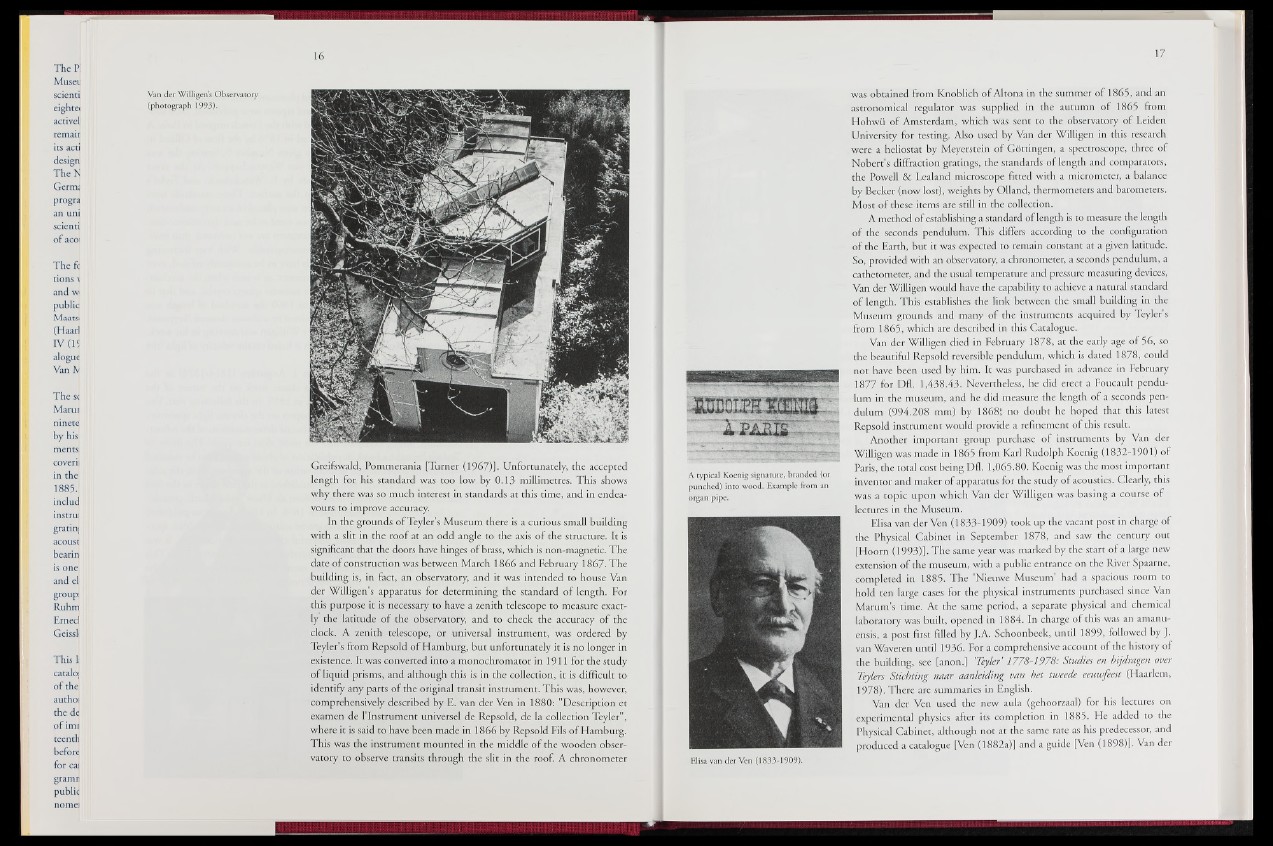
The P:
Musei;
scienti
eightei
activel
remair
its actj
design
TheN
Germ<
progra
an uni
scienti
of aeoi
The fc
tions ^
and w
public
Maatsi
(Haarl
IV (1S
alogue
Van Iv
The se
Marui
ninete
by his
ments
coverii
in thè
1885.
includ
instrui
gratin]
acoust
bearin
is one
and el
group:
Ruhm
Ernecl
Geisslt
This L
catalo]
of thè
authoi
thè de
of imi
teenth
before
for cai
gramn
public
nomei
Van der Willigens Observatory
(photograph 1993).
Greifswald, Pommerania [Turner (1967)]. Unfortunately, the accepted
length for his standard was too low by 0.13 millimetres. This shows
why there was so much interest in standards at this time, and in endeavours
to improve accuracy.
In the grounds ofTeyler's Museum there is a curious small building
with a slit in the roof at an odd angle to the axis of the structure. It is
significant that the doors have hinges of brass, which is non-magnetic. The
date of construction was between March 1866 and February 1867. The
building is, in fact, an observatory, and it was intended to house Van
der Willigen's apparatus for determining the standard of length. For
this purpose it is necessary to have a zenith telescope to measure exactly
the latitude of the observatory, and to check the accuracy of the
clock. A zenith telescope, or universal instrument, was ordered by
Teyler's from Repsold of Hamburg, but unfortunately it is no longer in
existence. It was converted into a monochromator in 1911 for the study
of liquid prisms, and although this is in the collection, it is difficult to
identify any parts of the original transit instrument. This was, however,
comprehensively described by E. van der Ven in 1880: "Description et
examen de l'Instrument universel de Repsold, de la collection Teyler",
where it is said to have been made in 1866 by Repsold Fils of Hamburg.
This was the instrument mounted in the middle of the wooden observatory
to observe transits through the slit in the roof. A chronometer
A typical Koenig signature, branded (or
punched) into wood. Example from an
organ pipe.
was obtained from Knoblich of Altona in the summer of 1865, and an
astronomical regulator was supplied in the autumn of 1865 from
Hohwii of Amsterdam, which was sent to the observatory of Leiden
University for testing. Also used by Van der Willigen in this research
were a heliostat by Meyerstein of Gottingen, a spectroscope, three of
Nobert's diffraction gratings, the standards of length and comparators,
the Powell & Lealand microscope fitted with a micrometer, a balance
by Becker (now lost), weights by Olland, thermometers and barometers.
Most of these items are still in the collection.
A method of establishing a standard of length is to measure the length
of the seconds pendulum. This differs according to the configuration
of the Earth, but it was expected to remain constant at a given latitude.
So, provided with an observatory, a chronometer, a seconds pendulum, a
cathetometer, and the usual temperature and pressure measuring devices,
Van der Willigen would have the capability to achieve a natural standard
of length. This establishes the link between the small building in the
Museum grounds and many of the instruments acquired by Teyler's
from 1865, which are described in this Catalogue.
Van der Willigen died in February 1878, at the early age of 56, so
the beautiful Repsold reversible pendulum, which is dated 1878, could
not have been used by him. It was purchased in advance in February
1877 for Dfl. 1,438.43. Nevertheless, he did erect a Foucault pendulum
in the museum, and he did measure the length of a seconds pendulum
(994.208 mm) by 18681 no doubt he hoped that this latest
Repsold instrument would provide a refinement of this result.
Another important group purchase of instruments by Van der
Willigen was made in 1865 from Karl Rudolph Koenig (1832-1901) of
Paris, the total cost being Dfl. 1,065.80. Koenig was the most important
inventor and maker of apparatus for the study of acoustics. Clearly, this
was a topic upon which Van der Willigen was basing a course of
lectures in the Museum.
Elisa van der Ven (1833-1909) took up the vacant post in charge of
the Physical Cabinet in September 1878, and saw the century out
[Hoorn (1993)jf|The same year was marked by the start of a large new
extension of the museum, with a public entrance on the River Spaarne,
completed in 1885. The 'Nieuwe Museum had a spacious room to
hold ten large cases for the physical instruments purchased since Van
Marum's time. At the same period, a separate physical and chemical
laboratory was built, opened in 1884. In charge of this was an amanuensis,
a post first filled by J.A. Schoonbeek, until 1899, followed by ].
van Waveren until 1936. For a comprehensive account of the history of
the building, see [anon.] 'Teyler' 1778-1978: Studies en bijdragen over
Teylers Stichting naar aanleiding van het tweede eeuwfeest (Haarlem,
1978). There are summaries in English.
Van der Ven used the new aula (gehoorzaal) for his lectures on
experimental physics after its completion in 1885. He added to the
Physical Cabinet, although not at the same rate as his predecessor, and
produced a catalogue [Ven (1882a)] and a guide [Ven (1898)]. Van der
Elisa van der Ven (1833-1909).